International fixtures have arrived, our site has match analysis to dissect the tactics of national teams, such as Frank de Boers’s Holland. However, it is worth taking time to review the performances of several clubs, especially on how they were dealing with tight fixtures and without a preseason training camp.
This tactical analysis delves into the new elements of Pep Guardiola’s Manchester City. Despite not having the easiest start of the campaign, the 49-year-old head coach has endless ideas to stimulate his team. Given only 13 first-team players were available in the worst case, the manager must tweak his tactics to handle different opponents.
Manchester City obtained three wins, a draw and a loss in their first five games. Two of the five victories came from the Carabao Cup, while the Citizens were hammered by Leicester City at the Etihad weeks ago.
Dynamic build-up and the 1-3-6 shape
Since İlkay Gündoğan has been unavailable because of tested COVID-19 positive, Pep only has Fernandinho and Rodrigo Hernández at that holding midfield position. Aymeric Laporte was out for the same reason, and he needed time to regain fitness before playing an intense match. Also, the team were without Sergio Agüero and Bernardo Silva for most of the time, Phil Foden pushed as one of the front three.
Not many options for Pep, so he went with Rodri and Fernandinho playing together, in front of the central defenders. Because of this change, the build-up of the team changed a bit by pushing the full-backs into advanced positions early. The shape of the team varied from a 1-3-1 to a 1-2-2 in the first phase, including Ederson as one of them.
Below is an example of the 1-3-1 shape. Rodri was instructing Benjamin Mendy to go high and wide, while Fernandinho dropped as the right centre-back. This was an approach that aimed to pull the second line defender in the same vertical zone, it was Harvey Barnes in this case. By having spaces and avoiding back-to-goal, the temporary wide centre-back could bring the ball forward or play without pressure. Fernandinho could play a diagonal ball to Mendy, because of spaces provided around him.
The positionings of this temporary back three were highly flexible. Sometimes it could be Rodri to drop between the centre-backs, or operating as a false left-back. What matters were the ideas behind, they were just some of the variations of “La Salida Lavolpiana”.
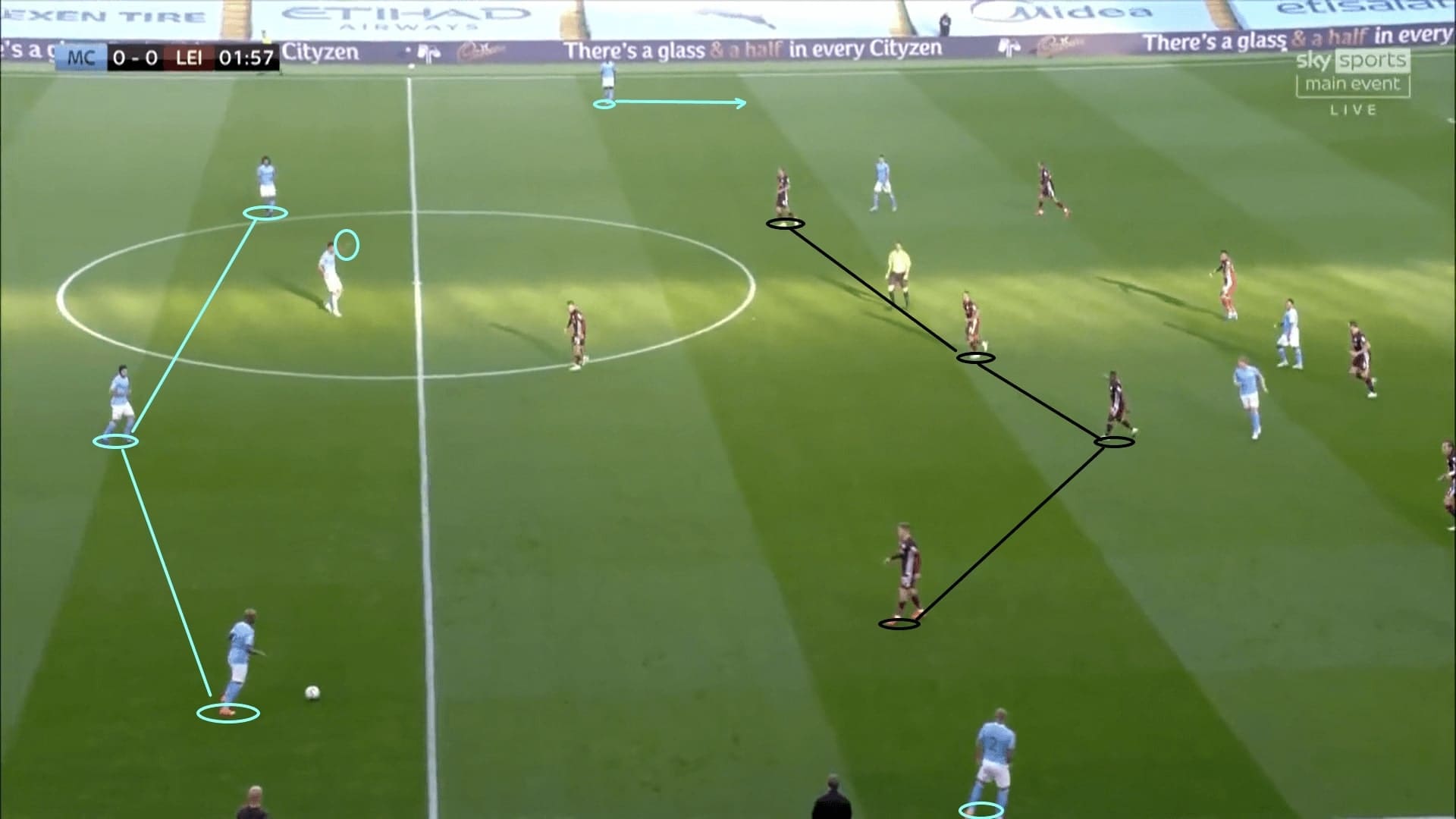
The use of double-pivot helped the team to break the pressure when confronting high press. Usually, one of the pivots stayed at the centre to manipulate the first line or the supportive second layer, while another one moved to offer himself as an additional option. Therefore, City should have more than one progressive point for the ball.
This tactic was very useful against teams defending with two strikers. By splitting the centre-backs wide, the first line of the opposition was dismantled – Daniel Podence and Raúl Jiménez moved sideways to mark John Stones and Nathan Aké below. On most occasions, the defending side pushes a midfielder to control the pivot, so João Moutinho was on Rodri. Therefore, Fernandinho became the viable free option to play out from the press, as Wolves were reluctant to sacrifice another player to control another pivot.
If the opponent pushed the second line higher or committed another player to control both pivots, spaces must be available behind the midfield. In those cases, the inverted wingers or a full-back would enter those regions to exploit the vertical gaps in the defence. Meanwhile, the offensive height must be provided by a pacey player, such as Raheem Sterling or Ferrán Torres to stretch vertical gaps.
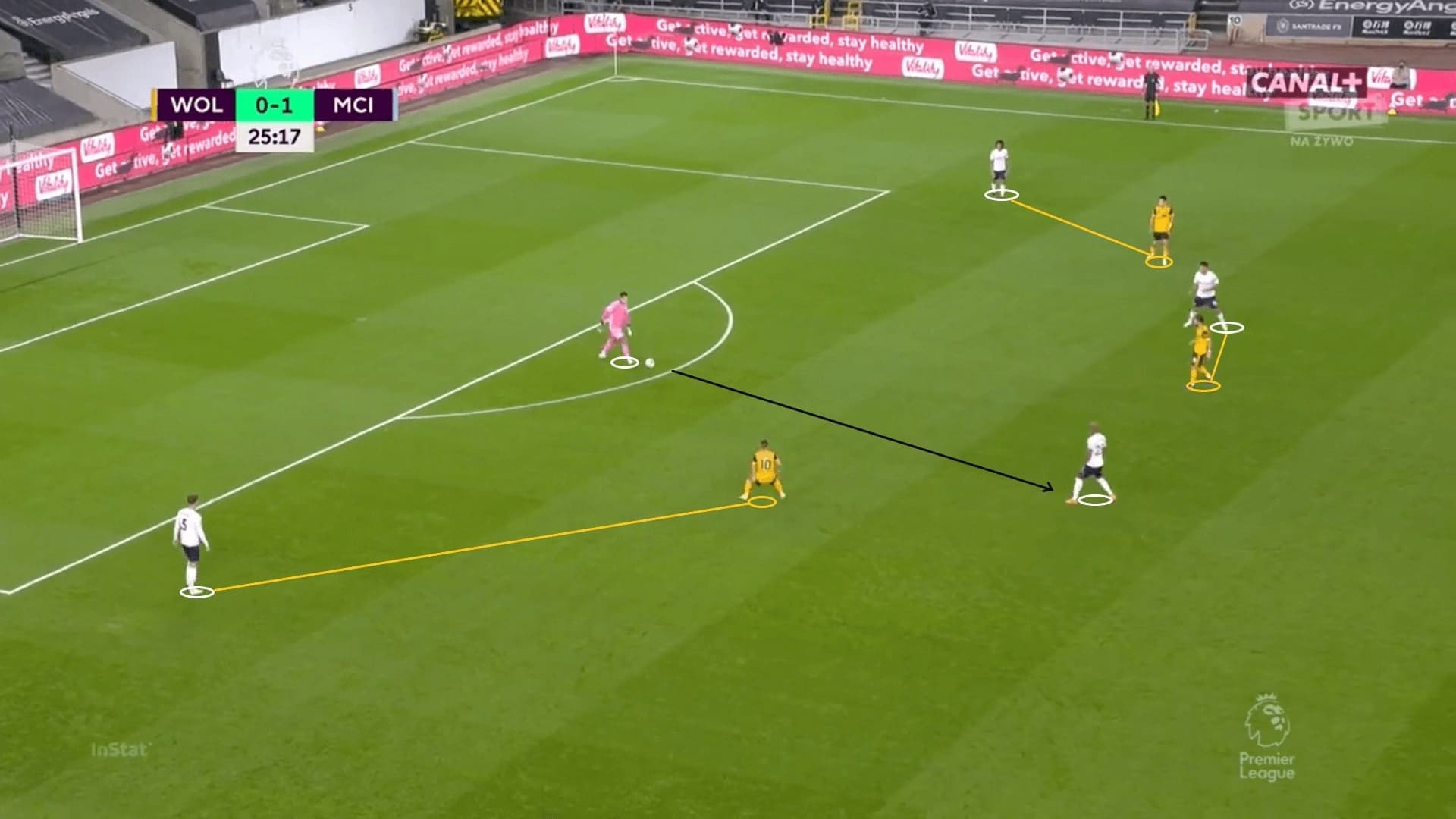
The EFL Cup game against Bournemouth was a special one, as Pep rested Benjamin Mendy, without playing any left-back on the pitch. The opponents were defending in a 5-3-2 or 5-3-1-1 midblock, and these dynamics use of pivots has faded the potential issues in the build-up.
Since Adrián Bernabé seldom participated in the first phase as the left-back, the position was taken by Rodri temporarily, while Tommy Doyle positioned himself centrally. The duties of Rodri was similar to Kevin De Bruyne’s against Wolves – it was a hybrid role. The most important job for the Spanish midfielder was to connect plays, while the other one kept the zonal defenders at the centre.
The below example was a variation, as the build-up shape changed to a 2-3, as Doyle, Rodri and Kyle Walker stayed on the same horizontal zone. The opponents were unable to catch the defence because of the relative width and options provided at the second build-up line. Furthermore, the opposition backline was manipulated by the City offensive height providers. The impacts of without a proper left-back was almost nullified in the first phase.
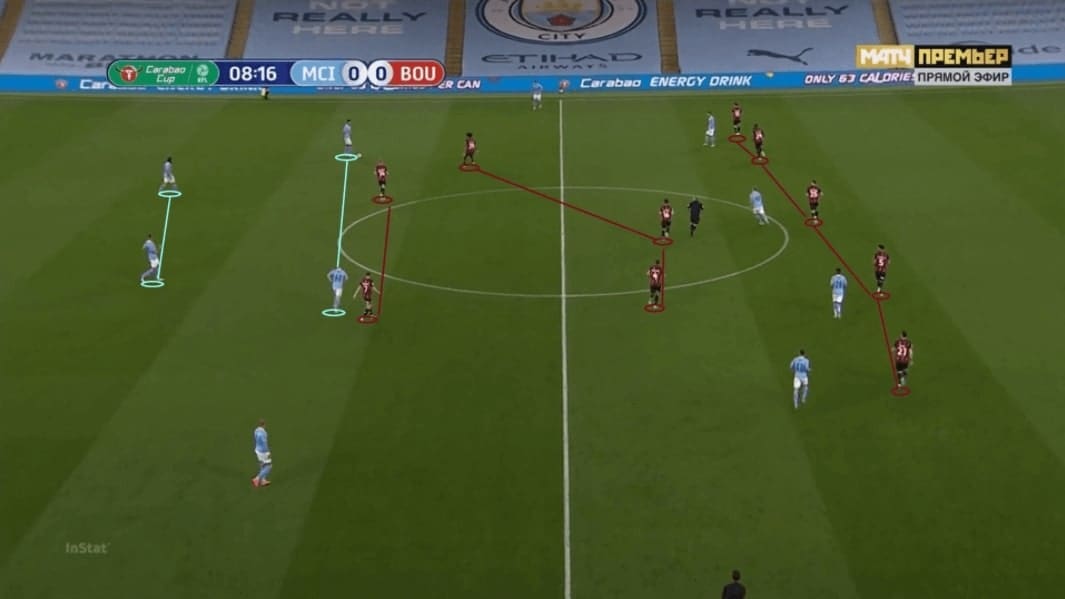
Because of the use of double-pivot, City could release both full-backs to attack the wide zones in the final third, which was rarely seen in the past four years. The best example came from the first half in the Leicester game, who defended in a 5-4-1 shape. What City were trying to do were to create six attacking channels to stretch the defence, just liked a 1-3-6 or 3-1-6 offensive structure.
Despite conceding five in this game, we have to admit that City suffocated most counter-attacks in the first half. Leicester equalized from a nice build-up, but not an offensive transition. The control of the game was down to the double-pivot as well, as well as Aké who formed the second line with them. The offensive markings were shown in the below image. These three players should position themselves corresponding to horizontal gaps between the Leicester midfielder line. During possession turnover, they should be able to catch any opposition midfielder quickly.
The idea was to open six attacking channels, and the final aim was to overload and attack the box with numerical superiority. Without Foden and Sterling as the front players, they should enter those zones when the ball arrived from wide zones. The offensive pattern, ideally, should be Fernandinho-Mendy-target or midfielder-Walker-target.
In this case, Walker’s wide positioning has dragged the left wing-back out of position, while the roaming Riyad Mahrez took the left centre-back out of position. The 3 v 2 numerical overloads was clear at the centre, and the dynamism of the attack was created as De Bruyne could attack the box late.
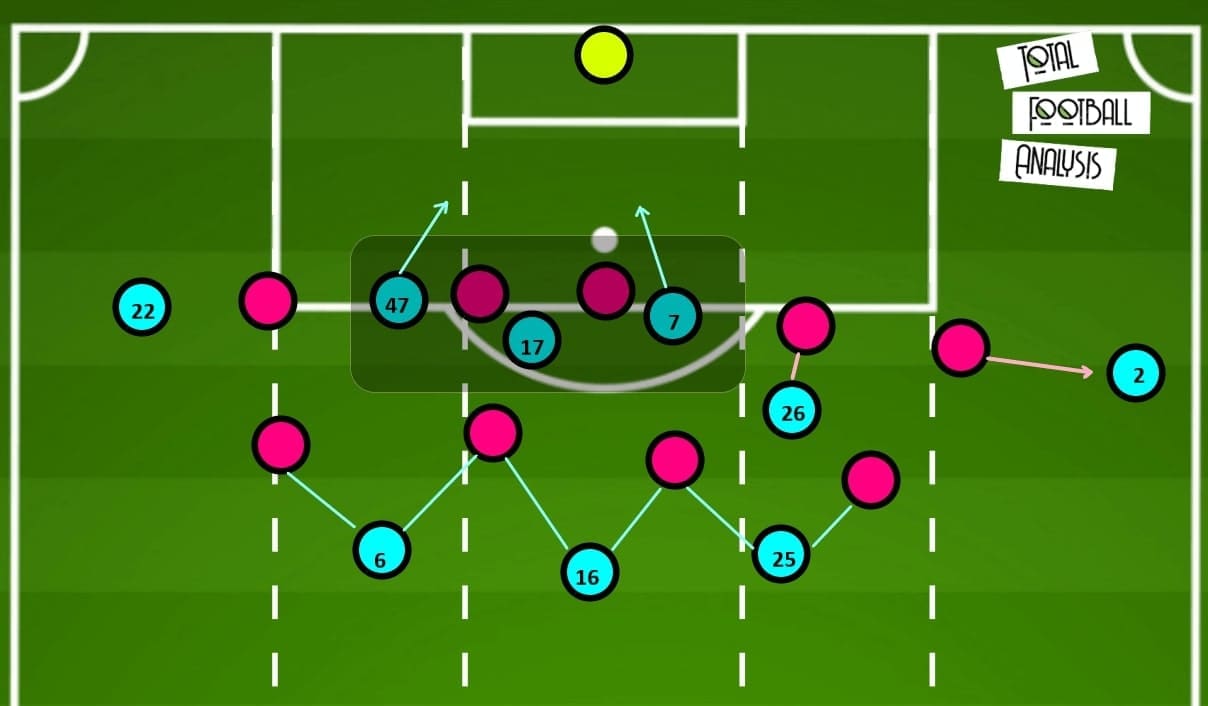
The above idea to attack Leicester’s back five was decent, but some issues in the execution part forced Pep to abandon the plan during halftime. The most difficult part for the team was the way to enter the final third, as the players must pay attention to the finest details, such as passing to the front foot of the wide receivers. However, Aké was yet to develop such passing ability to find Mendy effectively, while the diagonal balls from Fernandinho were too redable for the defence.
Eventually, City could not generate enough rooms for the wide players to cross from the wide zones. The favourable 3 v 2 scene at the centre seldom appeared, as Foden and De Bruyne moved sideways to create passing triangles in the build-up. The shape was illustrated in the below example. Even the players crossed, the chance of success was small as Sterling was the only one player in the penalty zone, while Leicester had three.
Another issue was Walker’s 1 v 1 ability and crossing skills. Physically, he was a decent player. However, when he was the player to receive the ball at the underloaded side, the English right-back could done better by dribbling in zone 18. Instead, he tended to find Mahrez more often.
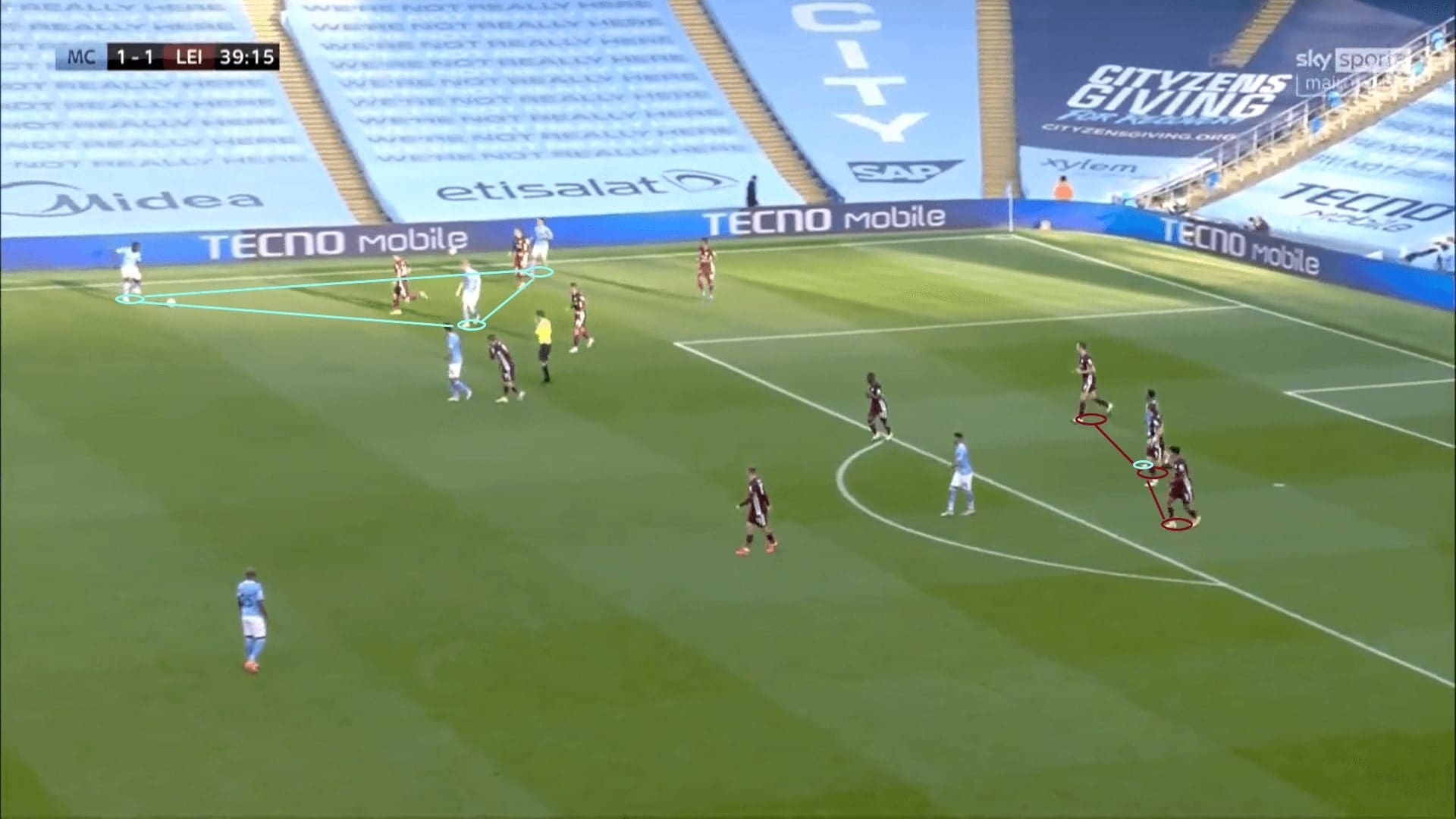
In fact, Laporte should still be the first choice as the left centre-back. The Frenchman defender has good understanding on what the manager requires, as well as possessing the ability to execute. In the Burnley game, City finally fully released the offensive calibre of Mendy, who was hugely criticized.
In the second EFL Cup game, the Clarets defended in a 4-4-2, what City did was to exploit half-spaces. Mendy did a huge role by providing the width, pulling the right-back wider and playing the ball back to the inside of the pitch. Before all of these from happening, the presence of Laporte allowed City to keep sending the ball to Mendy’s front foot. Laporte was very comfortable to bring the ball out of the first line, while this pass always bypasses the second line.
City had been trying to avoid verticality at Turf Moor, as the relatively flattened and close front three at the Leicester game hindered quick combinations.
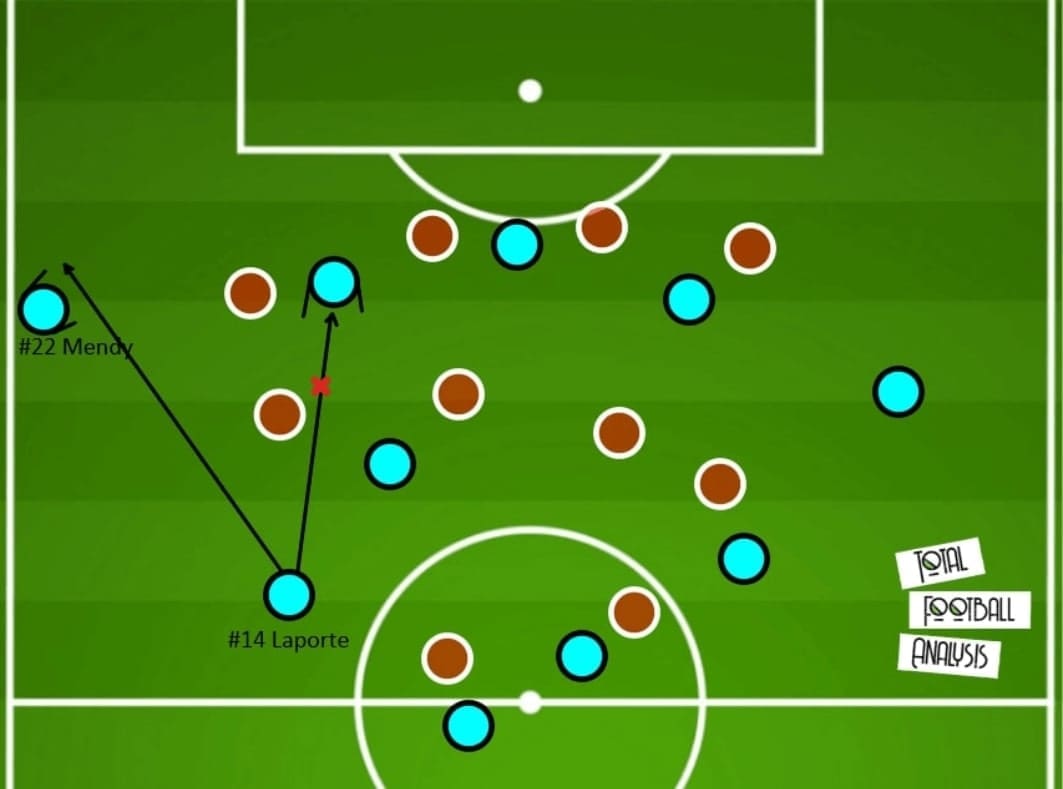
In the Leeds game, City did things very differently from usual because they faced Marcelo Bielsa’s team. With even fewer passes (397:364) than the opponents, using a slower tempo in the build-up was not what Pep wanted.
Instead, all defenders were encouraged to carry the ball forward. Against a highly man-oriented team, the best strategy to beat the defensive scheme was to utilize qualitative superiorities to create numerical superiorities. Only after the ball carrier beat his marker, another defender must step up to press at the expense of leaving the original target, that means a 2 v 1 overload was created temporarily. Perhaps they could be more clinical in that game.
Search for attacking depth
Another change of City was their constant search for attacking depth in open plays. It was a bit different from the previous years, as Gabriel Jesus and Agüero tended to drop as a “false-9”, adding an extra man at the midfield. Sterling somehow served the same function, but City did things slightly differently by inverting the wingers, encouraging them to run behind the lines. Hopefully, this could pin the opposition to defend deeper to compress spaces, which made Guardiola to feel safe, as he always wishes to keep the ball far away from Ederson.
In the Wolves game, the behaviours to attack spaces behind the defence was a strong tool to create goal-scoring opportunities. Against a man-oriented backline, Pep’s men used this tactic to generate spaces, and exploiting them.
The first example shows Jesus and Sterling running forward. Fernandinho – the carrier, should have two options to choose. The run from Jesus must pulled Conor Coady to a wider position, while Sterling could capitalize spaces pre-occupied by the Wolves skipper as another passing option. Given the pace of the English international, he could always arrive at the right spaces at the right momentum.
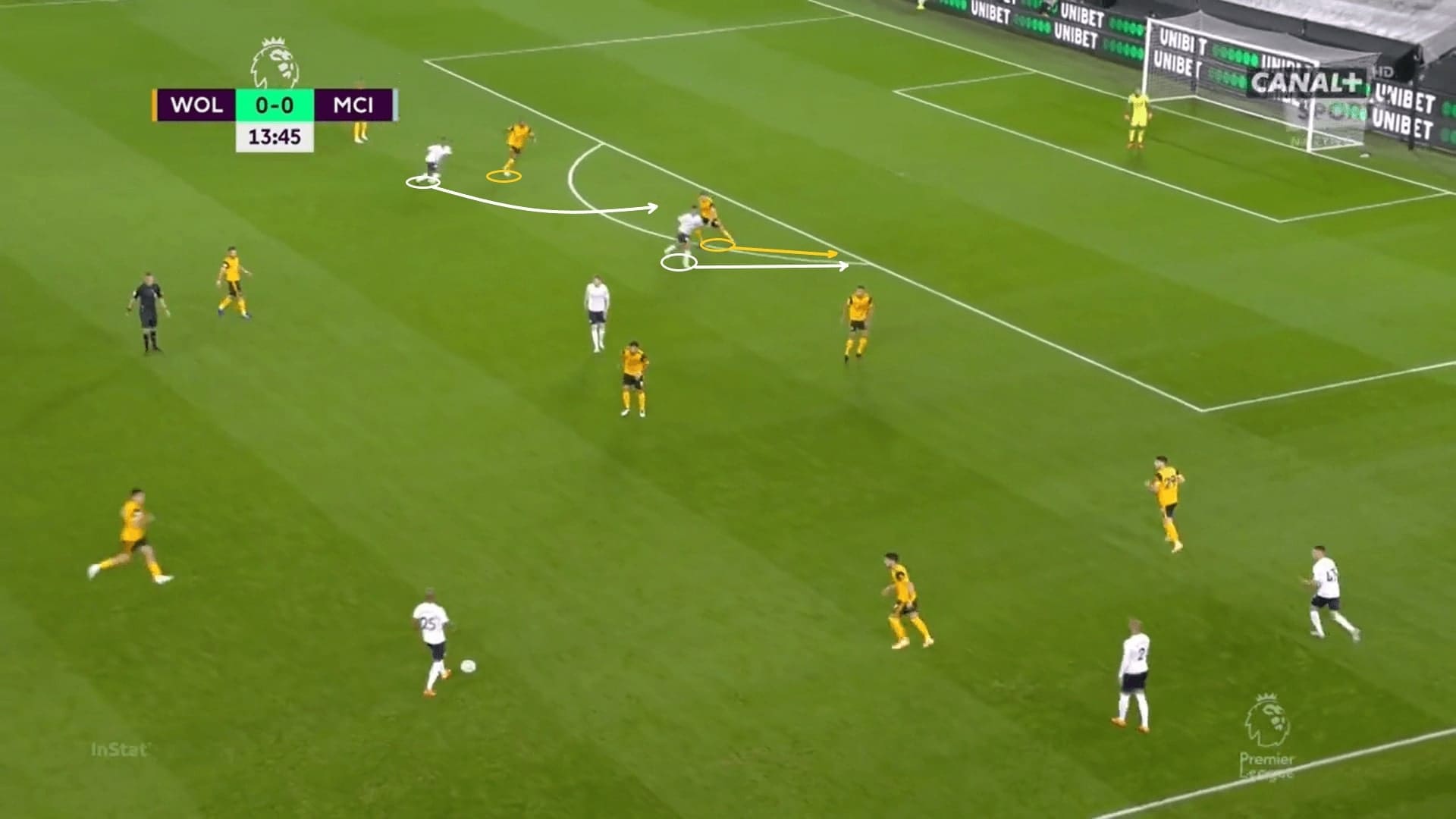
A concept was introduced in this game – relative height. It means the team do not have to occupying the highest point of the attack at every vertical channel. Instead, what Pep wanted was the player too attack spaces in front of the ball, as crossings from deep and diagonally might led to a chaotic game.
In this example, Jesus dropped deeper, but Sterling was already on this side of the pitch, despite playing as a left-winger. As a result, Adama Traoré and Wily Boly had nothing to defend on the far side. Under these circumstances, Sterling always arrived the destination earlier, including this case. The defence must adapt to such a kind of behaviour when dealing with City.
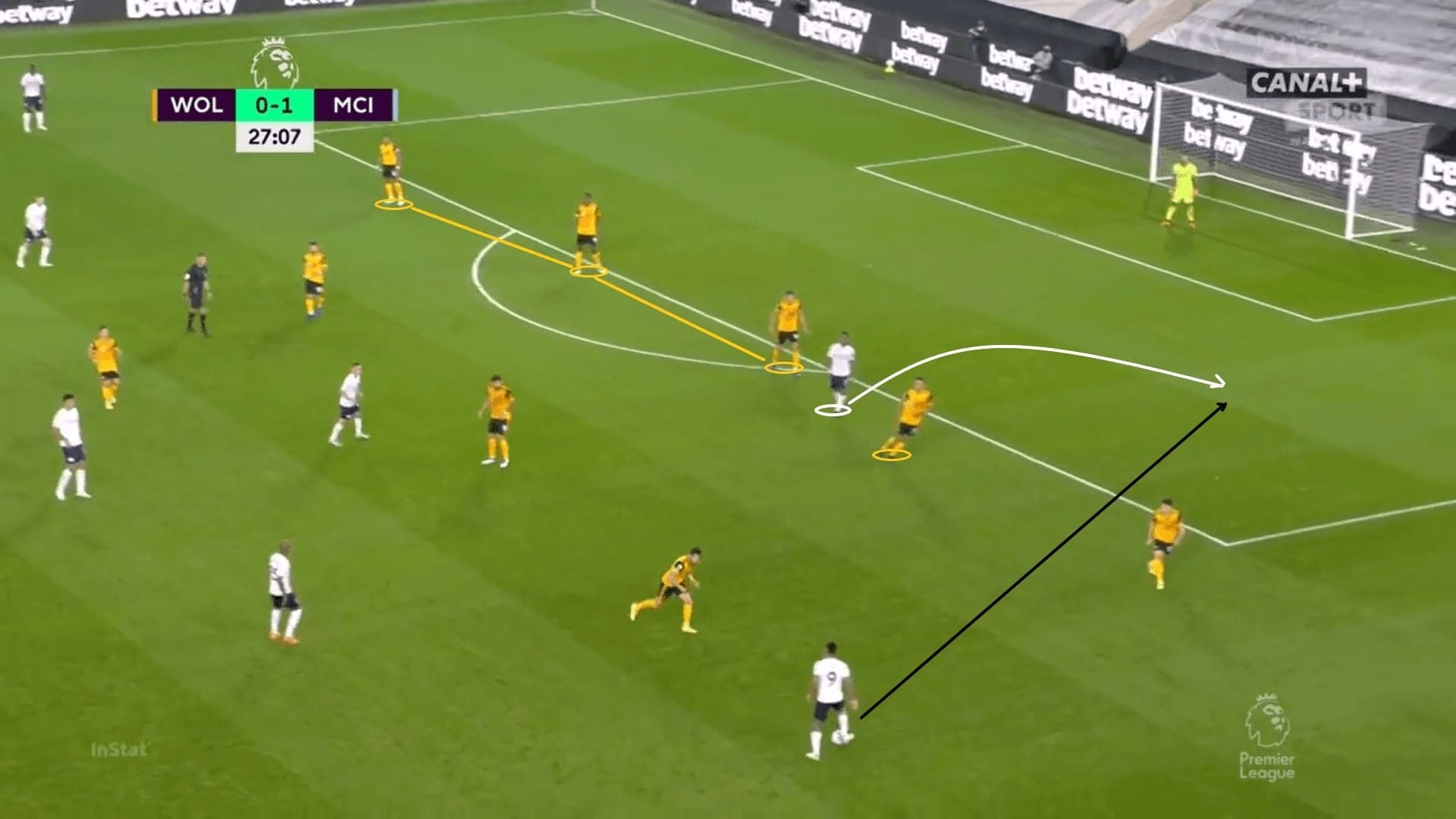
Sterling, if being deployed as a striker, would still drop deep to receive the ball. However, another player must provide the offensive height to compensate – it could be Mahrez or Torres. Of course, in this example, when the striker went that deep, the defence would almost never track him, and the offensive heights were provided by Mahrez, De Bruyne and Mendy.
The highest players always signaled to request a lofted pass from the midfield, as they were looking to attacking spaces behind the defence always. When the Foxes pushed themselves at the edge of the defensive third, spaces for the keeper to cover were large. Ideally, this should have created more 1 v 1 opportunities against the keeper.
However, the runners must pay attention to the positionings of defenders to avoid offside. Also, as Mahrez did in this example, they should move laterally until the ball was released.
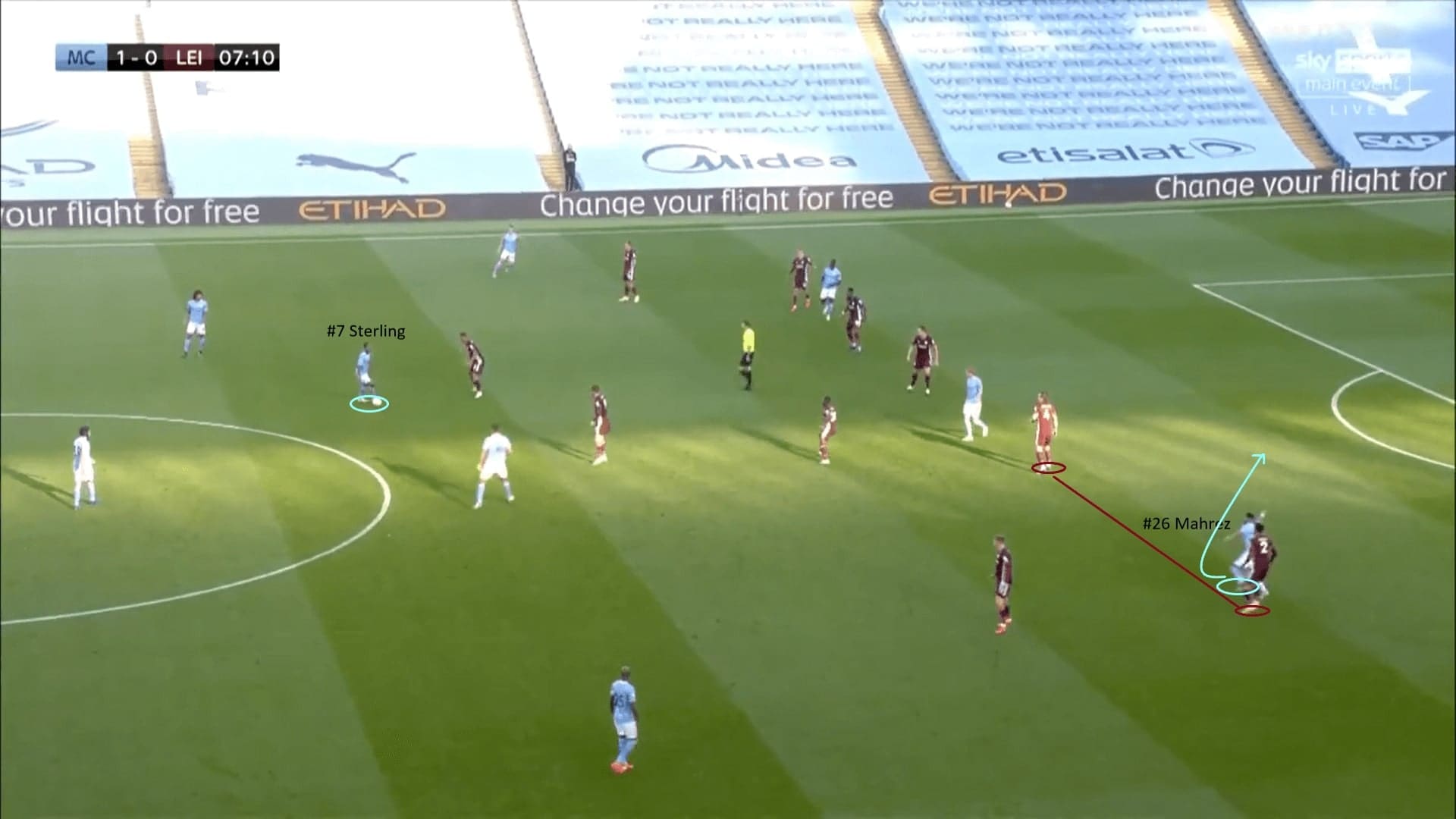
City do not cross because of crosses, at least it was applicable when the game was in-control. This season, Pep’s men were even crossing more cautiously than ever to avoid unnecessary counter-attacks. In the Bournemouth game, City sometimes chose to circulate the ball even arriving at zone 18, as Walker was reluctant to cross without a clear purpose.
City were trying to attack the penalty box with the following pattern – Walker to play a backward pass from high positions, the defence would push higher and leave the penalty box. Therefore, the pre-occupied zone would be free and the far side attackers could attack those spaces. Also, given the reversed directions of the pushing defensive line and attacking runners, hardly could the defence adjust to catch the run. All they needed was the diagonal pass or crosses from the edge of the box.
The below example has shown the flow of the attack: Walker – Mahrez – Mendy (attacker). Meanwhile, the Bournemouth defence was leaving the box, unable to instantly get onto the left-back. In those cases, the far side target could look for a cross or even having a 1 v 1 opportunity against the keeper.
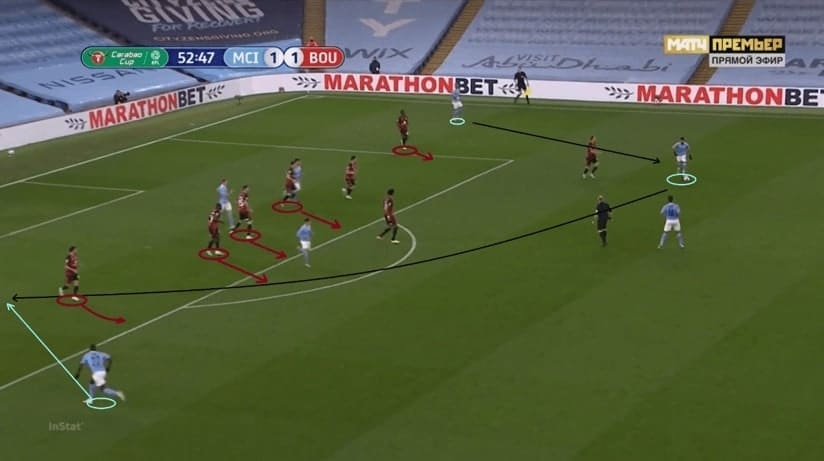
Rodri needs someone to share the workload
The pressing scheme of the team did not change completely this season, some parts of the setups were unnegotiable. It must be a zone-oriented defence, using the curve runs to win the ball cleverly. Nevertheless, some issues might require the attention and fixation of the coaching staff in the future.
The below example demonstrates the basic setups of City’s high press, including the use of pressing traps. The wingers to mark the centre-backs, while the striker should cover the pivots or spaces at the centre. Here, Sterling on Robin Koch while Torres was on Liam Cooper; Mahrez was shadowing Kalvin Phillips to limit his receiving angle. They only pressed the goalkeeper when the press began. Either winger would first curve their runs, forcing the centre-back to find the keeper, then continued to press the keeper.
The pressing trap was set on the receivers behind the first line, where the midfield trio could jump to the passing lanes and intercept the ball. Illan Meslier thought Luke Ayling was a free option here, but that was read by De Bruyne early and City regained possession high.
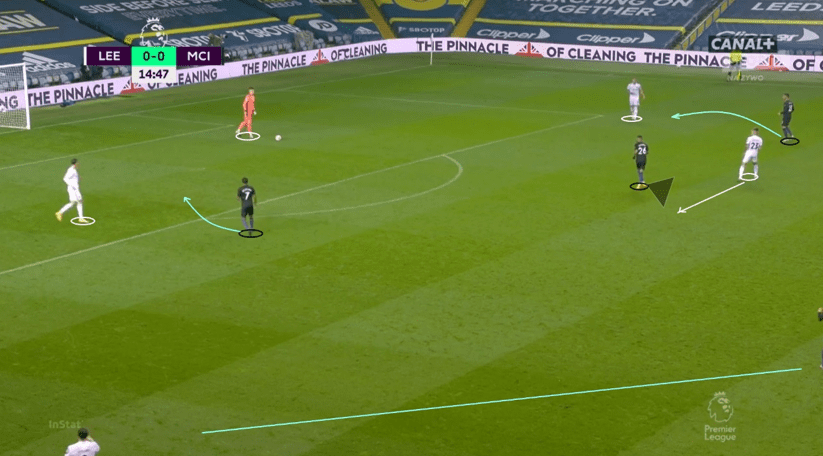
The biggest issue was the vertical compactness of the defence. Since City suffered a lot from the high line last year, the last line was set slightly deeper this year. However, this left an enormous zone for Rodri to cover, and it was unreasonable to require the sole pivot to cover all these areas.
When facing against teams that opened the shape big, using both touchlines to attack, the relatively lower pressing intensity often led to backfire. City struggled to cope with the opponent when they were circulating the ball at the backline, as the 4-3-3 defence lacked horizontal coverage.
The following instance was one of them, which was a scenario in the Leicester game. City totally failed to control the wing-backs of the opponents, did not put enough pressure on Kasper Schmeichel to force a difficult pass. Therefore, the ball flew to James Justin comfortably.
And, the wide midfielders were slow to close to cover the wide players as they were travelling from distances. Fernandinho was slow to access Justin, De Bruyne was deeper to track runs, leaving the midfielder as a free option. Consequently, Rodri had a difficult task since he was underloaded in a 1 v 2. It was difficult to press as too much spaces appeared at the centre.
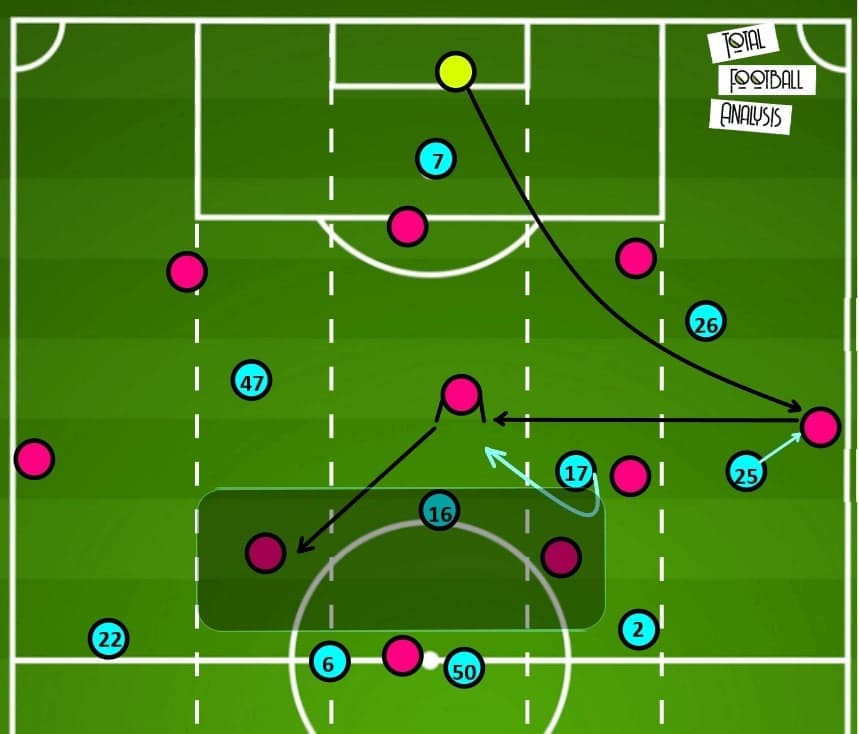
Below was a game example at Turf Moor. Since the front players were not pressing intense enough to guide the angle and direction of the long ball, Burnley could attack around Rodri’s zone.
Even Laporte stepped up to fight for the first ball, Rodri’s chance to win the second ball was small because his zone had two Bunrley players. This underloaded zone and heavy workload of Rodri might allow the opponent to play behind the press with a third man play, or up-back-through pattern.
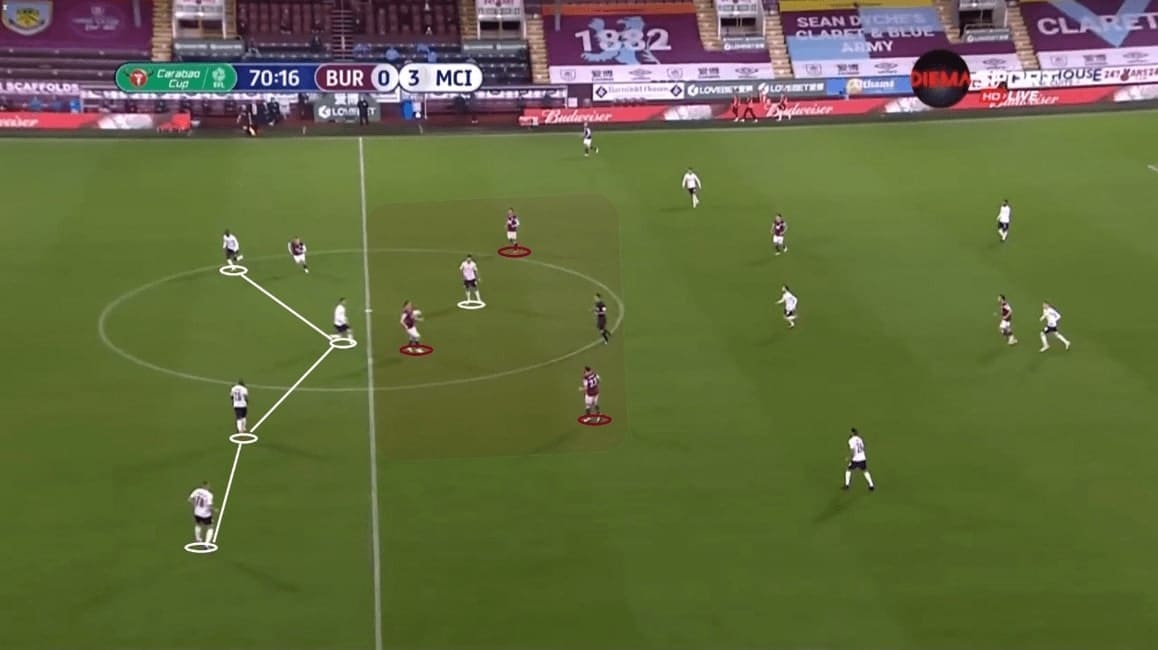
The below example was another dimension of the vertical compactness issue, as well as the vulnerability at flanks. Since Sterling pushed very high to press, spaces on the left were without protection.
Against teams such as Wolves that liked to overload a flank, it was difficult to trap the ball to suffocate the attack. Under Nuno Espírito Santo, Jiménez always operate as a temporary right-winger for the long balls. With another midfielder and Traoré in that zone, City often lose the second ball – too much for Rodri and Mendy to cover.
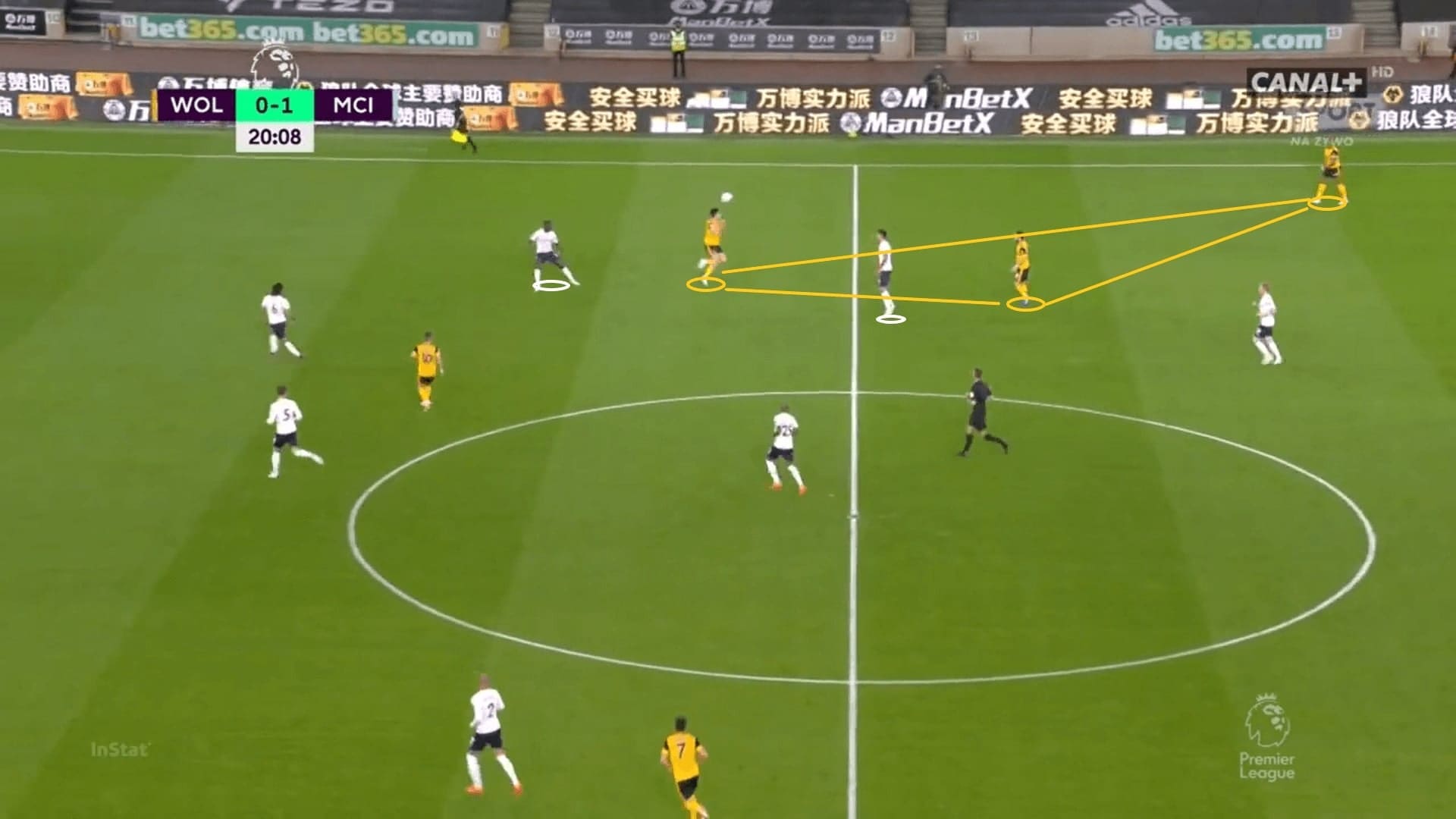
Underlying issues
City were a decent team, with top players in the world. However, it was still at the beginning of the season and there were some underlying issues. The performance of Pep’s troops was would slightly drop in the first 15 minutes of the second half, especially when they were out-of-possession.
As a consequent, the team conceded a lot of opportunities from 45th to 60th minute. They suffered a lot when Wolves, Leicester, and Leeds came back stronger. The below charts represent the xG dynamics of the above three games, the stories were somehow similar. City started better, creating more chances, but after the break, the opposition xGs increased drastically – the trends are the same.

From a tactical point of view, the offside trap might be an underlying issue of the team. It is a must for every team to play with a high line, when doing well, the vertical areas of defending was minimized. Nevertheless, it was a risky approach as one defender napped, the efforts of the other three were in vain.
Sometimes City set decent high lines and offside traps to prevent the counter-attacks. Sometimes one of the defenders recognized the situation slower than the others, potentially leading to dangerous moments. Fortunately, the opponents were yet to exploit this issue.
In this example, Eric García pushed higher to set an offside trap, but Walker did not realize the behaviour of his teammates. The offside trap has failed, Leicester just could not flip the ball to Jamie Vardy. It could be a dangerous situation.
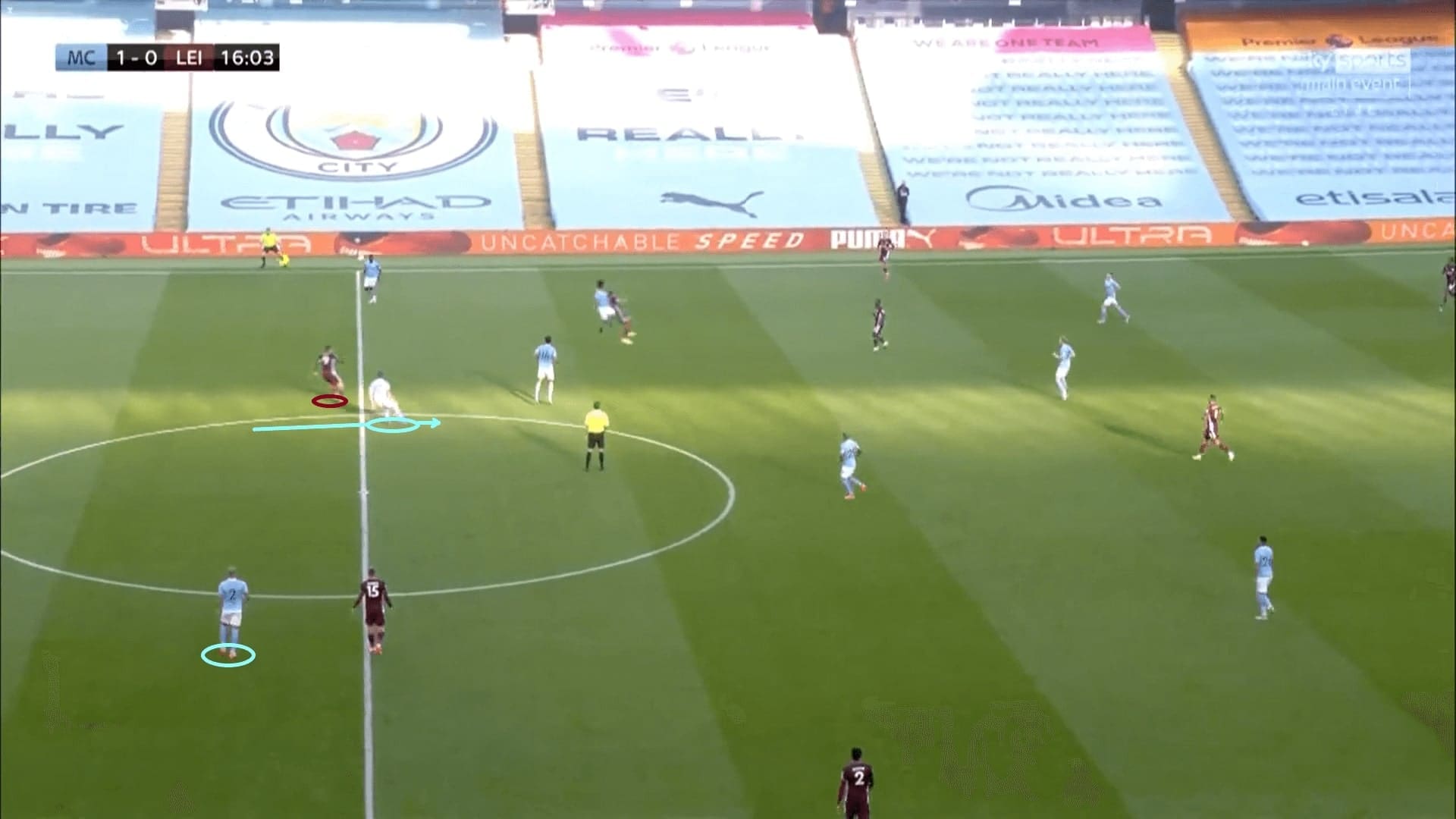
Mentally, City must improve to search for greater success in the UEFA Champions League. It was about the way they deal with ordeals or conceding goals in a game. The Leicester game was not that bad, at least the scoreline was not reflecting the whole story. However, as the manager has said, the team thought they played bad even it was not the case.
Consequently, even Pep tried to tweak the details and regain control of the game, the efforts were in vain as the players might be having a bad mood. Some talents looked to dribble at the centre of the pitch, maybe even neglecting passing options. And even world-class player like De Bruyne was a bit lost, kept crossing from deep despite the chance of success was negligible. The crossing graphs below were from the Leicester. In the first half, the crosses only came from zone 16 and zone 18, while Mahrez and De Bruyne tried many unsuccessful attempts by crossing early in the second half. With City’s quality, the players should have believed in themselves, carried out the game plan.
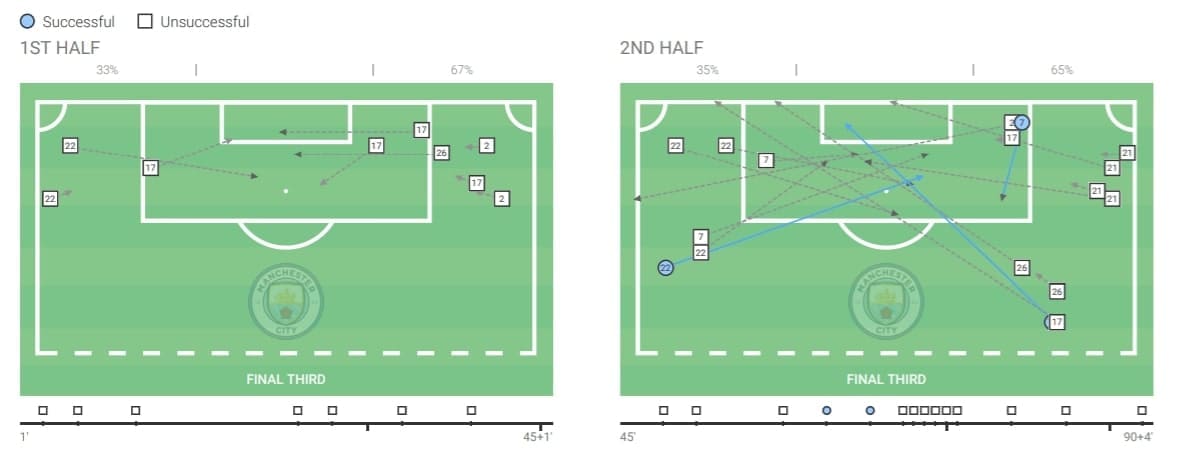
Tweaking individual roles
The last part of this analysis briefly touches on changes of individual roles as a complement of the team analysis. Walker and Mahrez were picked in this section as their roles changed the most in September.
Walker was famously known as the inverted right-back, or even playing as a right centre-back for the country after joining City. It seemed Pep wanted him to do things slightly differently. Walker is quick, and this physical superiority should be able to convert into qualitative superiority in the wide zones, mostly zone 16.
Therefore, now Walker could operate high and wide as a winger in the wide areas. It was an aggressive approach as Pep would expect him to attack the isolated defender in 1 v 1 situations, and crossing to the penalty box. The below tables are the average offensive stats of the right-back, the upper one was last season’s numbers while the lower one was mean of the first five games. Walker had more shots (0.52 – 0.99), crosses (2.24 – 2.58), dribbles (1.91 – 4.57), offensive duels (3.78 – 6.36) in his game, but with fewer progressive runs (3.69 – 2.19) which might indicated his fading role in the build-up.

Another big change was Mahrez’s role. The Algerian winger was extremely strong in 1 v 1 situations, and mostly being deployed as the isolated wingers to create the dynamics. For example, the goal he scored against Leicester after dribbling past Ben Chilwell was a typical Mahrez goal.
In other words, Mahrez was closer to the sideline in the previous campaign. In this season, he was deployed as the left-winger, and even the striker. Or, as a right-winger, he has more freedom to roam his positions on the pitch. This means the player is closer to the opposition goal.
The below heat maps of Marhez have shown the changes. The left one was from last season, which Mahrez seldom participated the attack on the opposite flank. This season, the Algerian winger was not only appearing at zone 14, but also on the opposite touchline. It was reasonable to expect Mahrez scoring more and assisting more if he continued in this role.
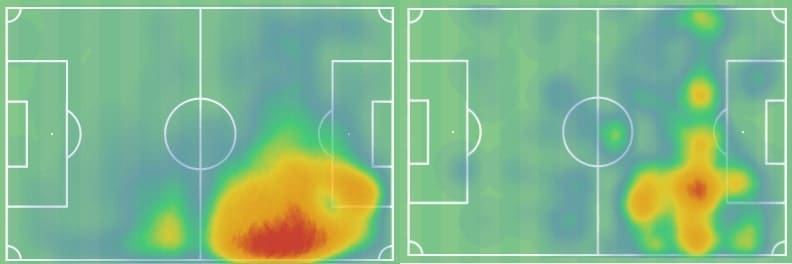
Final remarks
It was not the best start of City, but we all know it is a very difficult season given the short time of preparation and the injury list. As shown in this scout report, Pep has been trying to adapt, implementing new ways to demolish the opponent.
The offensive tactics were introduced because of the available personnel of the team, and they were also efforts to solve some long-lasting issues since last season. Some were good, and some needed more adjustments to achieve perfection. It is just the beginning of the season, we expect to see more from Pep in the future, start from the Arsenal game at this weekend.



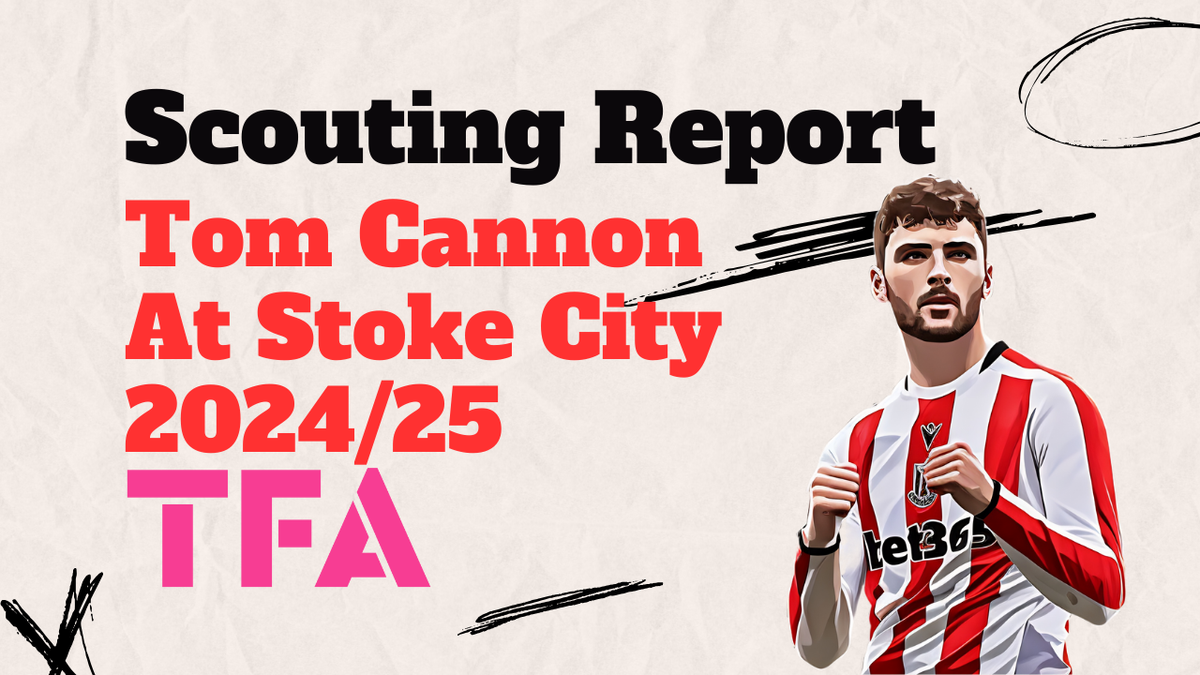
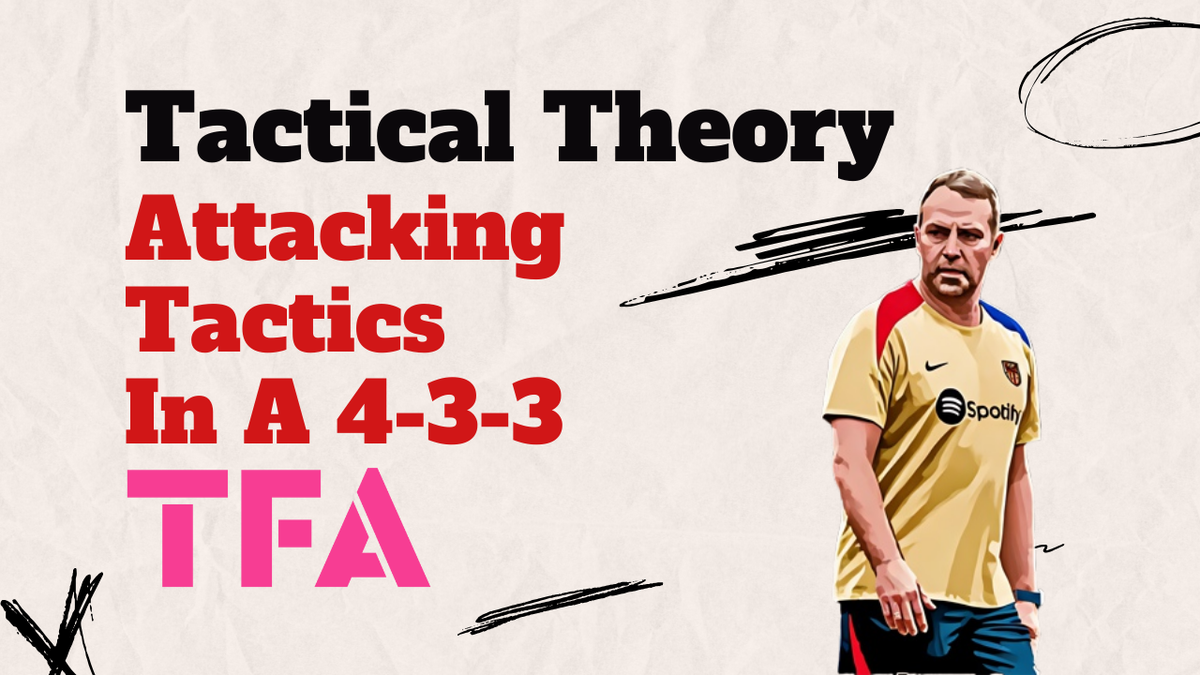
Comments